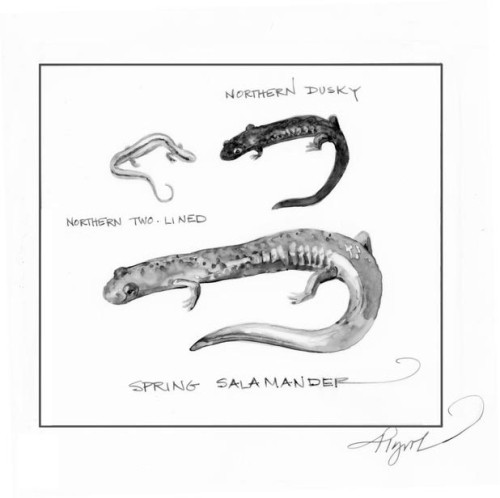
Many residents of Vermont and New Hampshire are familiar with salamanders such as the eastern newt (and its terrestrial form, the red eft, which can often be found along hiking trails and logging roads after summer rains) and the spotted salamander with its large yellow polka dots. Few, however, have become acquainted with our region’s three species of stream-side salamanders – the northern two-lined, the northern dusky, and the spring salamander.
All three are members of the Plethidontidae family, the largest family of salamanders, containing 375 species or so worldwide. Also known as the “lungless salamanders,” Plethodontids absorb oxygen directly through their moist skin.
The smallest, most abundant, and most widely distributed of this trio is the northern two-lined salamander (Eurycea bislineata). A slender, yellowish-bronze salamander with two dark stripes along its sides, the two-lined can probably be found in most every stream and rocky seep in Vermont and New Hampshire. Adults are easily found by overturning rocks or logs along stream edges, when they often dash away quickly with a wriggling, snake-like motion.
In spring or early summer, females attach 1- to 3-dozen eggs in a small, grape-like cluster to the underside of a rock in the flowing water of a stream. The few larvae that survive their first year without being washed away or eaten by a variety of predators (including other stream salamanders) metamorphose into adults after 2 or 3 years.
The northern dusky salamander (Desmognathus fuscus) is a medium-sized, stream-dwelling species. While this species’ appearance can be rather variable, in the limited light of a shady, forested streambank, it usually appears quite dark. In good light, however, most individuals are light to dark brown with a scalloped, dark band along the back.
Dusky salamanders have noticeably larger hind legs and are the only salamander that I’ve ever seen jump; more than once a captured dusky has leapt out of my hand to its freedom. While there is some overlap in the type of drainages where dusky and two-lineds are found, duskys appear to have a narrower tolerance for water temperature and water quality – usually being absent from warmer or muddier streams in non-forested or disturbed areas.
The dusky’s 10-30 eggs are laid in summer, usually in a damp, often mossy area adjacent to a stream. Instead of abandoning her clutch after laying it, like the two-lined salamander, the female dusky coils around her eggs for the duration of the incubation period. Being cold-blooded, brooding females are not “incubating” their eggs like a bird but simply defending the clutch against predators. Several researchers have shown that females displaced as far as 100 feet from their nests will relocate them using chemical cues and resume brooding. Interestingly, females rarely abandon their eggs, even when disturbed, but clutches that are abandoned often suffer complete mortality.
The spring salamander (Gyrinophilus porphyriticus) is the least common, largest, and most impressive of our stream salamander trio. An attractive, salmon-colored animal with fine black streaks or spots, the spring salamander may reach 8 inches in length – large enough to eat two-lined salamanders and all but the largest duskys. This species is limited to the cool waters typically found in well-shaded, highly oxygenated mountain streams, where they occur in low densities. In the spring they can also be found in damp, mossy areas or seeps adjacent to streams where they have spent the winter.
Relatively few spring salamander nests have been found, leading scientists to speculate that most females probably lay their eggs in deep underground recesses in streams or seeps. Of the nests that have been found, most were attached to the undersides of rocks or logs within the streambed. Hatching occurs in late summer or fall, and the larvae spend 2 to 4 years transforming into 4 or 5 inch long adults.
Finding and capturing a spring salamander requires a fair amount of patience, a strong back, and a modest amount of skill. Try wading into a high gradient mountain stream –the kind of stream that drowns out most other nearby sounds with its gurgles, ripples, and cascades. Then begin turning over rocks that are a foot square or larger, especially those that are on the stream’s edge and not buried in sand or mud. Walk upstream as you go along so that the muck, leaves, and other debris you stir-up will wash away behind you without clouding your view. Don’t expect to find one right away, because like bobcats, peregrine falcons, and other top predators, spring salamanders are not abundant. If you do find one, catching it won’t be easy. Springs are very fast and lively, not to mention slippery, so a good aquatic dip net or a 12-year old child can be helpful here.

